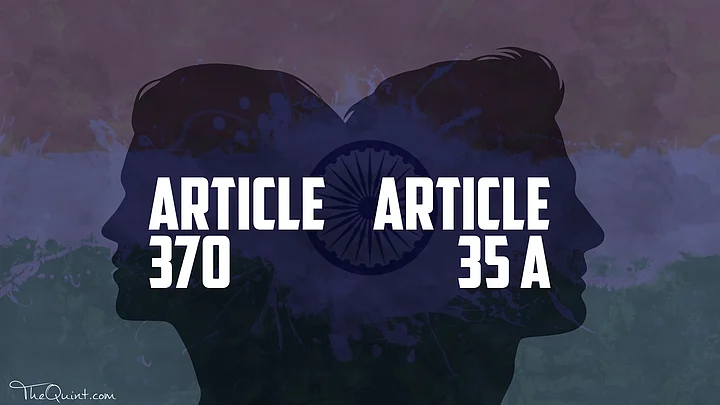On Monday, 5 August, as Union Home Minister Amit Shah moved a resolution seeking the revocation of the provisions of Article 370 of the Constitution and introduced a Bill to bifurcate the state of Jammu & Kashmir, many questions were raised and many clarifications did the rounds.
Questions about the Constitutional soundness of the move as well as the region’s administration hung heavy. A number of senior lawyers have shared their insights on the notification and the Bill.
The Quint has curated the voices of four legal experts: Harish Salve, Subhash Kashyap, Soli Sorabjee and Aryama Sundaram, to decode, based on what they say, what the most important issues are:
Has Article 370 Been Revoked?
Subhash Kashyap, Constitutional Expert
“Article 370 has not been repealed. Article 370 is very much there, unlike what many channels are announcing. Article 370(1) is very much there. Only two clauses have been removed,” Kashyap told ANI
Harish Salve, Former Solicitor General of India
“370 is a Constitutional provision which says that ‘Such provisions in the Constitution as the President may from time to time direct will apply in Jammu & Kashmir. There was a 1954 order which has been superseded now. It was a Presidential order superseded by a Presidential order,’ Salve said.
Is Article 35A Part of the Constitution?
Harish Salve:
“Merely because it is called Article 35A, there was a grave misunderstanding that it is a part of the Constitution. It never was a part of the Constitution.”
Aryama Sundaram
Sundaram reiterated that the whole issue of Article 35A is pending in the Supreme Court, before the Constitution Bench.
“Because don’t forget, Article 35A was introduced not through a Constitutional amendment but merely through a Presidential order, with the President exercising powers under Article 370(2) and it’s way back in 1954, I’m talking about.”
“It’s just that till now it has not really created too many problems but over the last few years the Kashmir problem have escalated the way it has, Article 35A is being looked at very seriously as is the whole concept of continuing with Article 370,” he added.
Is the Move Constitutionally Sound?
- 19 June 2018: Jammu & Kashmir came under Governor’s rule for a six-month period after the the PDP-BJP coalition government collapsed.
- 21 November 2018: Governor Satyapal Malik dissolved the legislative Assembly.
- 20 December 2018: The Central government imposed President’s Rule after the six-month tenure of Governer’s Rule came to an end. The state has been under President’s Rule ever since.
Subhash Kashyap
“I can only say Constitutionally it is sound. No Constitutional or legal fault can be found in it and the government has carefully studied the matter and taken this decision,” he told ANI.
“To the extent that this is a political decision it is entirely up to the government and political parties to have their views.”
Aryama Sundaram, Senior Lawyer, Supreme Court
“If there is no Assembly at that time and it has to be governed by Presidential Rule, I would say it would hold until the Assembly is convened and when there is an Assembly it has to be ratified immediately after by the Assembly,” he told BloombergQuint.
“But it can’t be that if there is no Assembly and it is only under President’s Rule then in the meantime you cannot legislate at all that appears to be a bit anomalous and I don’t see how you can leave a vacuum like that,”
What is the Next Step Now ?
Soli Sorabjee, Former Attorney-General of India
“The laws of India which were not applicable to the state of Jammu & Kashmir will now apply. But for that you require Parliamentary approval. The Bill will have to be moved in Parliament, and as far as I can see, it will be passed because BJP has a majority there.”
Harish Salve
“So, first step will be Parliament acting as the Assembly of Jammu & Kashmir consider the bifurcation and then Parliament will pass the reorganisation Bill and as and when that is done, the bifurcation will take place.”
The Rajya Sabha passed the Jammu & Kashmir Reorganisation Bill to bifurcate Jammu & Kashmir into two Union Territories – J&K and Ladakh by a majority of 125 to 61 votes. One member abstained from voting.
How ‘Temporary’ is Article 370, Exactly?
Aryama Sundaram
“The heading of Article 370 starts with ‘temporary’. It is creating its own friction of how permanent is temporary becoming and that seems to be an issue now. It is something that we’ll have to see,” he told ANI.
“It’s not going to end with Section 144 and there is a lot more which will follow but it will all – but in the end it will all going to lead down to one thing: Is Kashmir a part of Unitary India or not? And if it is about time that Kashmir also adopts the ethos of the rest of the country,”
Subhash Kashyap:
“It is another myth that Article 370 gives special status to Jammu & Kashmir. It is part of Part XXI of the Constitutional and Part XXI of the heading is “Transitional, Temporary and Special Provisions”. For some states like Nagaland, there are special provisions and special status has been granted to those states.”
“But in the case of J&K, the heading is very clear – it is a temporary provision and temporary means only for a temporary period for a temporary ad-hoc purpose. The Constitution makers did envisage that it can be removed, amended or repealed in the future.”
(At The Quint, we question everything. Play an active role in shaping our journalism by becoming a member today.)
